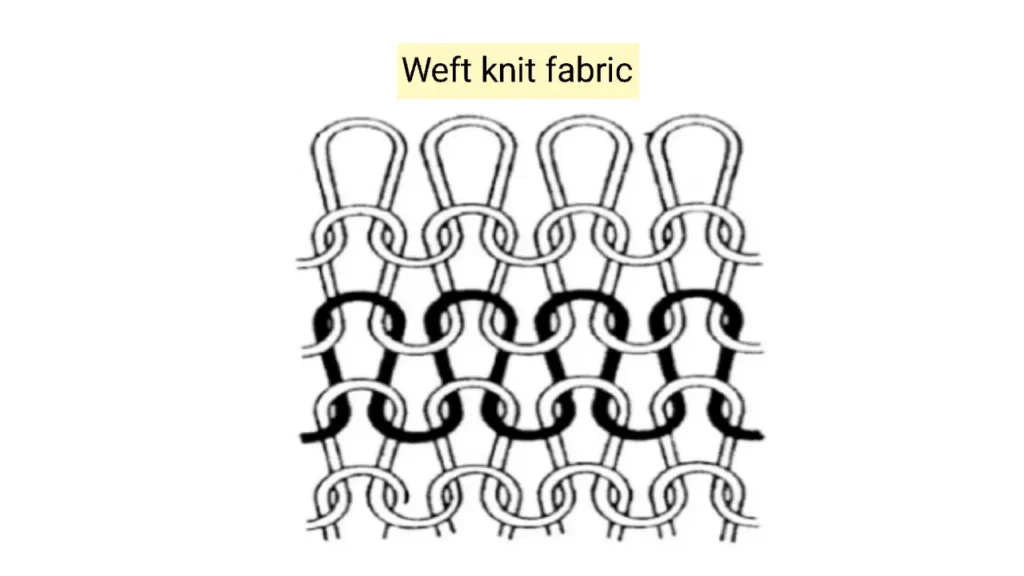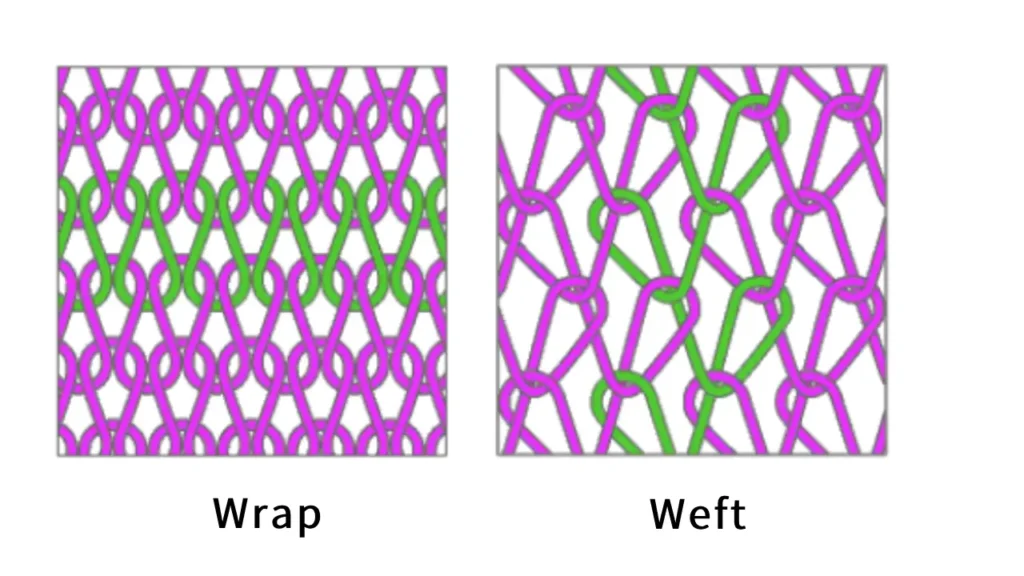Weft knit fabrics, created through horizontal looping of yarns, offer a unique blend of comfort, stretch, and versatility. Unlike warp knits, weft knits can be produced on circular or flat knitting machines, allowing for a wide range of textures and patterns. Understanding the diverse types of weft knit fabrics is essential for selecting the right material for specific garment and textile applications.
This blog post will explore the various types of weft knit fabrics, highlighting their distinct characteristics, benefits, and common uses. From the everyday comfort of jersey knit to the structured elegance of interlock, each weft knit type brings unique advantages to the table. We’ll delve into how these fabrics are used in apparel, home textiles, and beyond, providing insights to guide your fabric selection.
What is Weft Knit Fabric

Weft knit fabric is a type of knitted fabric created by interlacing yarns horizontally, forming loops that run across the width of the fabric. This process differs from warp knitting, where yarns run vertically. In weft knitting, a single continuous yarn (or multiple yarns) is fed into the knitting machine, and loops are created and connected in a horizontal direction, allowing the fabric to stretch widthwise.
This horizontal looping construction gives weft knit fabrics their characteristic stretch and flexibility. The fabric’s stretchability makes it ideal for a wide range of garments, from comfortable everyday wear like t-shirts and sweaters to form-fitting apparel like leggings and dresses. Weft knits are also used in home textiles, such as blankets and upholstery, due to their soft texture and draping qualities. Common examples of weft knit fabrics include jersey, rib knit, and interlock.
Types of Weft Knit Fabrics
Understanding the variety of weft knit fabrics is essential for selecting the right material for diverse garment and textile applications. Weft knits, characterized by their horizontal looping construction, offer unique benefits in terms of stretch, comfort, and drape. Here’s a breakdown of common weft knit types, including their benefits and uses.
Jersey Weft Knit Fabric
Jersey weft knit is a single weft knit fabric, known for its flat, smooth face and slightly ribbed back. It’s typically made from cotton or blends, offering a soft, stretchy, and comfortable feel. The simple, looped structure of jersey weft knit makes it versatile and widely used in everyday apparel. Jersey weft knit’s lightweight nature and excellent drape make it ideal for garments like t-shirts, casual dresses, and lightweight tops.
Benefits: Jersey weft knit provides excellent comfort due to its soft texture and flexibility. Its breathability makes it suitable for warm weather, and its ability to drape well enhances the garment’s fit. Jersey weft knit is also relatively easy to care for, making it a practical choice for everyday wear. The fabric’s stretch allows for a comfortable fit, adapting to body movements without feeling restrictive.
Uses: Jersey weft knit is commonly used in t-shirts, casual dresses, loungewear, and children’s clothing. Its versatility extends to home textiles like bed linens and lightweight blankets. The fabric’s ability to hold prints and dyes well makes it a popular choice for promotional apparel and fashion items. Its affordability and wide availability contribute to its widespread use in the textile industry.
Rib Weft Knit Fabric
Rib weft knit is a weft knit fabric characterized by its vertical ribs, created by alternating knit and purl stitches. This construction imparts exceptional elasticity and shape retention, making it ideal for cuffs, necklines, and waistbands. Rib weft knit is also used for form-fitting garments like sweaters and leggings, providing a snug and flexible fit. The ribbed texture enhances the garment’s ability to stretch and recover, ensuring it maintains its shape over time.
Benefits: Rib weft knit offers superior elasticity and shape retention, making it perfect for garments that require a close, comfortable fit. Its ribbed texture adds visual interest and enhances the garment’s structure. Rib weft knit is durable and maintains its shape even after repeated washing, ensuring long-lasting wear. The fabric’s ability to stretch and recover makes it ideal for cuffs, necklines, and waistbands, providing a snug and secure fit.
Uses: Rib weft knit is commonly used in cuffs, necklines, and waistbands for sweaters, jackets, and athletic wear. It’s also used in form-fitting garments like leggings, skirts, and dresses. Its versatility extends to home textiles like fitted sheets and blankets, where its elasticity and shape retention are beneficial. The fabric’s ability to provide a snug fit makes it a popular choice for thermal underwear and hosiery.
Interlock Weft Knit Fabric
Interlock weft knit is a double weft knit fabric that resembles jersey but is thicker and more stable. It’s created by interlacing two layers of jersey weft knit, resulting in a smooth, soft fabric with excellent drape and stability. Interlock weft knit is often used for high-quality t-shirts, dresses, and sportswear, offering a polished look and enhanced comfort. The double-layered construction minimizes curling and provides a refined finish.
Benefits: Interlock weft knit offers a smooth, stable fabric with excellent drape and a luxurious feel. Its double-layered construction makes it more durable and less prone to curling than jersey weft knit. Interlock weft knit provides a polished appearance, making it suitable for both casual and formal wear. The fabric’s stability and comfort make it a popular choice for premium apparel.
Uses: Interlock weft knit is commonly used in high-quality t-shirts, dresses, and sportswear. Its smooth surface and excellent drape make it ideal for garments that require a refined appearance. Interlock weft knit is also used in children’s clothing and home textiles like bedding, where its durability and comfort are beneficial. The fabric’s ability to hold its shape well makes it suitable for structured garments like skirts and jackets.
Pique Weft Knit Fabric
Pique weft knit fabric is a textured weft knit characterized by its raised, geometric patterns. It’s often made from cotton or blends and is commonly used for polo shirts and sportswear. The textured surface adds a touch of sophistication to casual wear, making it suitable for both athletic and semi-formal attire. Pique weft knit’s breathable and durable nature contributes to its popularity in various apparel applications.
Benefits: Pique weft knit offers a textured surface that adds visual interest and enhances breathability. Its durable construction makes it suitable for activewear and casual apparel. Pique weft knit maintains its shape well and is resistant to pilling, ensuring long-lasting wear. The fabric’s structured appearance makes it a popular choice for polo shirts and other semi-formal garments.
Uses: Pique weft knit is commonly used in polo shirts, golf shirts, and other sportswear. Its textured surface and breathable nature make it ideal for athletic wear. Pique weft knit is also used in casual dresses, skirts, and tops, adding a touch of sophistication to everyday wear. The fabric’s durability and easy care contribute to its widespread use in various apparel applications.
French Terry Weft Knit Fabric
French terry weft knit fabric is a soft, comfortable weft knit characterized by its smooth face and looped back. It’s typically made from cotton or blends and is used for sweatshirts, loungewear, and casual apparel. French terry weft knit’s looped back provides warmth and comfort, making it ideal for relaxed and cozy garments. The fabric’s versatility extends to both casual and activewear.
Benefits: French terry weft knit offers a soft, comfortable feel with moderate warmth. Its looped back provides a cozy texture and enhances insulation. French terry weft knit is breathable and allows for easy movement, making it ideal for loungewear and casual apparel. The fabric’s durability and easy care contribute to its popularity in everyday wear.
Uses: French terry weft knit is commonly used in sweatshirts, hoodies, and joggers. Its comfortable feel and moderate warmth make it ideal for loungewear and casual apparel. French terry weft knit is also used in children’s clothing and home textiles like blankets and throws. The fabric’s versatility extends to activewear, providing comfort and flexibility during workouts.
Fleece Weft Knit Fabric
Fleece weft knit fabric is a soft, warm weft knit characterized by its brushed surface, creating a plush, insulating texture. It’s typically made from polyester or blends and is used for sweatshirts, jackets, and blankets. The brushed surface traps air, providing excellent warmth and comfort. Fleece weft knit’s ability to retain heat and its soft feel make it ideal for cold-weather apparel and cozy home textiles.
Benefits: Fleece weft knit offers exceptional warmth and comfort due to its brushed, plush texture. Its insulating properties make it ideal for cold weather, and its soft feel enhances comfort. The fabric is durable and easy to care for, making it suitable for everyday wear and home use. Fleece weft knit is also lightweight, providing warmth without added bulk.
Uses: Fleece weft knit is commonly used in sweatshirts, jackets, and hoodies for cold-weather apparel. It’s also used in blankets, throws, and lining for added warmth. Its versatility extends to outerwear and sportswear, providing comfort and insulation during outdoor activities.
Velour Weft Knit Fabric
Velour weft knit fabric is a plush, soft weft knit characterized by its short, dense pile, creating a velvet-like texture. It’s often made from cotton or blends and is used for loungewear, tracksuits, and upholstery. Velour weft knit’s luxurious feel and comfortable drape make it a popular choice for garments that prioritize comfort and style. The velvety surface adds a touch of elegance to casual wear.
Benefits: Velour weft knit offers a luxurious feel and a comfortable drape, making it ideal for loungewear and casual apparel. Its soft, velvety surface provides a plush texture that enhances comfort. Velour weft knit is durable and maintains its appearance after repeated washing, ensuring long-lasting wear. The fabric’s ability to hold color well makes it suitable for vibrant and stylish garments.
Uses: Velour weft knit is commonly used in tracksuits, loungewear, and casual dresses. Its luxurious feel makes it suitable for upscale casual wear and home textiles like upholstery and decorative pillows. Velour weft knit is also used in children’s clothing and accessories, providing comfort and style.
Cable Weft Knit Fabric
Cable weft knit fabric is characterized by its raised, interwoven patterns that resemble cables or ropes. It’s created by crossing stitches over each other, forming three-dimensional designs. It’s often used for sweaters, scarves, and blankets. Cable weft knit provides warmth and a classic, textured look, making it a popular choice for cold-weather apparel and cozy home textiles.
Benefits: Cable weft knit offers a classic, textured look with excellent warmth and comfort. Its intricate patterns add visual interest and enhance the garment’s design. Cable weft knit is durable and provides excellent insulation, making it ideal for cold-weather wear. The fabric’s thickness and texture contribute to its cozy feel and stylish appearance.
Uses: Cable weft knit is commonly used in sweaters, cardigans, and scarves for cold-weather apparel. It’s also used in blankets, throws, and decorative home textiles. Its classic patterns make it a popular choice for traditional and stylish garments.
Jacquard Weft Knit Fabric
Jacquard weft knit fabric is a complex knit fabric that allows for intricate patterns to be knitted directly into the fabric. It uses a specialized knitting machine that can control individual needles, enabling the creation of elaborate designs, floral patterns, and geometric motifs. Jacquard weft knits are used in apparel, upholstery, and decorative textiles, providing a luxurious and artistic look.
Benefits: Jacquard weft knit offers intricate patterns and designs knitted directly into the fabric, providing a luxurious and artistic look. Its complex construction allows for detailed and unique patterns. Jacquard weft knit is durable and maintains its appearance after repeated washing, ensuring long-lasting wear. The fabric’s versatility makes it suitable for various applications, from apparel to home textiles.
Uses: Jacquard weft knit is used in apparel like dresses, skirts, and sweaters with intricate patterns. It’s also used in home textiles like upholstery, curtains, and decorative pillows. Its ability to create detailed designs makes it a popular choice for high-end and artistic textiles.
Weft Knit Fabric vs Wrap

Understanding the fundamental differences between weft knit and warp knit fabrics is crucial for selecting the right material for various textile applications. While both are types of knitted fabrics, their construction methods and resulting properties vary significantly.
Construction and Yarn Direction
Weft knit fabrics are created by interloping yarns horizontally, across the width of the fabric. This process involves a single continuous yarn (or multiple yarns) forming loops that run from side to side. In contrast, warp knit fabrics are made by interlacing yarns vertically, along the length of the fabric. Multiple yarns are fed simultaneously from a warp beam, and each yarn is guided by needles to create loops that run lengthwise. This difference in yarn direction and loop formation leads to distinct fabric characteristics.
Stretch and Stability
Weft knit fabrics typically exhibit greater stretch in the widthwise direction due to their horizontal loop construction. This makes them ideal for garments requiring flexibility and comfort, such as t-shirts, sweaters, and leggings. Warp knit fabrics, on the other hand, are more stable and have less stretch, particularly in the widthwise direction. They are known for their resistance to runs and unraveling, making them suitable for applications requiring durability and dimensional stability, such as lingerie, swimwear, and industrial textiles.
Fabric Properties and Uses
Weft knit fabrics are generally softer and more pliable, offering excellent drape and comfort. They are commonly used in apparel, home textiles, and casual wear. Warp knit fabrics, due to their tighter construction and stability, are often used in technical textiles, automotive applications, and high-performance sportswear. They provide a smooth, flat surface and can be produced in various weights and textures, offering versatility for specialized applications.
How to Choose the Best Weft Knit Fabric
Selecting the best weft knit fabric for your project involves considering several factors to ensure the fabric meets your specific needs. Understanding the fabric’s properties, such as stretch, drape, and durability, will help you make an informed decision. By evaluating these aspects, you can choose a weft knit fabric that provides the desired comfort, performance, and aesthetic.
Here are the key considerations when choosing weft knit fabrics:
Intended Use and Garment Type:
Consider the specific garment or textile you plan to create. For form-fitting apparel like leggings or bodycon dresses, you’ll need a weft knit with high stretch and recovery, such as rib knit or spandex blends. For casual wear like t-shirts, jersey knit or French terry are ideal, offering comfort and a relaxed drape. For structured garments like jackets or skirts, interlock knit provides stability and a polished look.
Fabric Weight and Drape:
The weight and drape of the fabric significantly impact the garment’s appearance and feel. Lightweight weft knits like jersey and voile offer a soft, flowing drape, perfect for summer dresses and tops. Medium-weight knits like pique and French terry provide a balance of structure and drape, suitable for polo shirts and loungewear. Heavyweight knits like cable knit and fleece offer warmth and structure, ideal for sweaters and blankets.
Fiber Content and Comfort:
The fiber content determines the fabric’s comfort and performance. Natural fibers like cotton and bamboo offer breathability and softness, ideal for everyday wear. Synthetic fibers like polyester and nylon provide durability and moisture-wicking properties, suitable for activewear. Blends combine the benefits of different fibers, offering a balance of comfort and performance.
Stretch and Recovery:
The stretch and recovery of weft knit fabrics vary depending on the knit structure and fiber content. High-stretch knits like rib knit and spandex blends are ideal for form-fitting garments, while low-stretch knits like interlock are suitable for structured apparel. Ensure the fabric has good recovery to maintain its shape over time.
Durability and Care:
Consider the fabric’s durability and care requirements. Durable weft knits like interlock and pique are suitable for garments that require frequent washing. Easy-care knits like polyester blends are ideal for activewear and everyday use. Check the fabric’s resistance to pilling, shrinking, and fading to ensure it maintains its appearance and quality.
By carefully considering these factors, you can select the best weft knit fabric for your project, ensuring a comfortable, durable, and aesthetically pleasing result.
Conclusion
Understanding the diverse types of weft knit fabrics, from the stretchy jersey to the textured rib knit, is essential for selecting the right material for various applications. Each type offers unique benefits, influencing comfort, drape, and durability. By recognizing the strengths of each weft knit, you can create garments and textiles that meet specific needs and preferences.
The adaptability of weft knit fabrics extends beyond apparel, finding uses in home textiles and industrial applications. This versatility highlights their importance in modern manufacturing. Whether you’re designing casual wear, athletic apparel, or cozy home furnishings, the right weft knit fabric can significantly enhance the final product’s quality and appeal.
For a comprehensive selection of high-quality wholesale weft knit fabrics, including jersey, rib knit, and more, explore our extensive catalog at Fanda Fabrics. We provide detailed specifications and expert guidance to help you find the perfect materials for your projects. Contact us today to request a quote and experience our exceptional service and competitive pricing.
